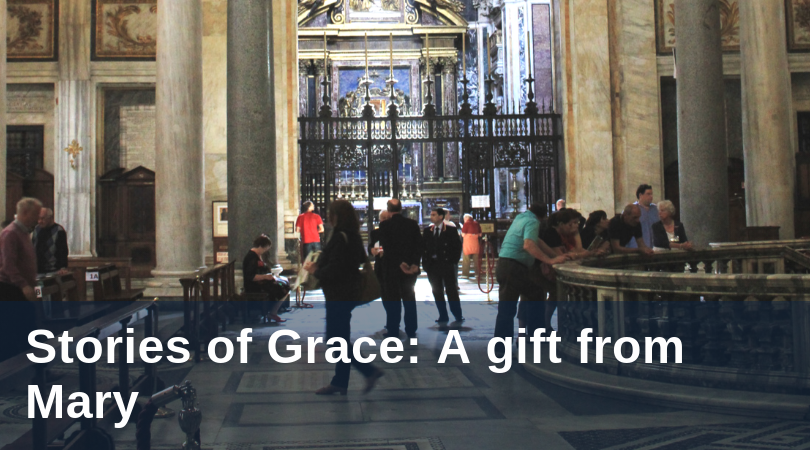
The morning light eased its way along the streets of Rome in a gradual awakening. I too ambled around the streets, enjoying my first morning in the city on my own. Now I’m sure I took the least efficient route, but eventually I arrived at Santa Maria Maggiore, the Basilica of Mary Major. The impressive white façade dominated the scene, and the interior was no less grand: rows of enormous marble pillars flanked the sides and intricate gold coffers covered the ceiling. My eyes couldn’t absorb enough of its splendor.
As the largest Catholic Marian church in Rome and one of the four major basilicas, I knew I had to see it. This past summer I studied abroad in Tuscany and only ventured to Rome a few times, so this particular basilica was at the top of my “to see” list. As with any sight-seeing experience (I don’t want to say I was a tourist, but I was), sometimes the brilliance of the art and architecture rolls right off you like water. Just another huge basilica so old we can’t wrap our minds around it. Yet, as an art lover I tried my hardest to appreciate the beauty, so I found the first available chair and pondered the fifth century frescos of Mary for a few minutes.
After wandering around some more, I found a small crypt of the nativity, which is said to hold a piece of the wood from the holy crib that Jesus was laid in. St. Jerome’s tomb also lies there. As in any holy place I tried to recollect myself and appreciate the astounding fact that right in front of me lay St. Jerome’s tomb and possibly a piece from Christ’s manger. But the crowds of tourists starting multiplying and pushed me away to seek a quiet place of refuge. I slipped into the first side chapel I happened upon and, hastily seating myself in the back, surveyed the scene: a few elderly people knelt praying the rosary and a priest prepared for Mass. Ah, I had made it just in time for daily Mass.
Throughout Mass I kept pinching myself to remember that this was Santa Maria Maggiore and that this basilica dates back all the way to 430s AD. During the homily, the priest’s Italian words faded into the background, and as I did not know enough to figure out his message, I let my mind wander. Then an elderly Italian man slid into the pew next to me and speaking Italian, asked in a whisper whether I was Italian. “No. Americano,” I said, recalling the popular coffee drink. He pressed a leather pouch marked with the papal seal into my hands, even though I tried to give it back. It was a rosary he said, this time in English, blessed by the Pope. He had worked for the Vatican for years, and insisted that I accept the rosary. I thanked him, and he said, “No, thank the Blessed Mother. And pray for my brother who is very sick. God bless you.” He left right after Mass. I examined the opaque white beads of the rosary and its papal seal. I had just received a rosary from a stranger in the basilica, dedicated to Mary no less. My previous struggles to focus on the religious significance of the basilica slipped away, and I thanked both the man and Mary for this small gift.
The encounter could have happened to anyone, and who knows if that elderly man just went around handing out rosaries afterwards, but I still treasure that moment and the rosary. Throughout my time in Italy I prayed using that particular rosary and discovered reminders of Mary wherever I went (although Italy is known for its devotion to Mary). Nevertheless, I’m certain Mary helped strengthen my relationship to God while I was in Italy, and does so even to this day.
While in Italy, I was the scholar in residence at a rustic hotel called Monteverdi in the Val d’Orica region of Tuscany. The hotel is really a collection of villas in a medieval village—Castiglioncello del Trinoro— on the top of a mountain, and the nearest town lies 7 km down the mountain. That meant that the nearest Catholic church was also 7 km away. I’m so thankful for the opportunity to have studied there, in a place of such remarkable beauty. Yet, I longed for fellow Christians with whom I could attend Mass and pray; I never found anyone willing to accompany me, so I hiked to Mass on my own. The feelings of loneliness and homesickness—especially thinking I was the only practicing Catholic there—led me to hike around the mountain everyday to clear my head and absorb the astounding views. Caught up in the whirlwind of my thoughts, on my first hike down I discovered a small Marian shrine just off the side of the dusty road. The shrine reminded me of the encounter in Maria Maggiore, and from then on I determined to pray with that rosary on my hikes down the mountain, comforted by the Marian presence.
The tangible nature of the beads and the steady rhythm of repeating the Hail Mary not only soothes me, but mimics little children who repeatedly ask for things from their mother. Away from my family and in an unfamiliar place, I went to Mary for assistance so that I could make the best of the time I was given in Italy. I think many will agree that saying the rosary with others acquires more force, as if instead of one child asking for things, a whole group of children are going to Mary. As the mother of God, Mary always leads us to her son with the loving care of a mother who hears our calls for help. No living human being is closer to Jesus than Mary, his mother, who held him as a child in her arms. When praying the rosary, I imagine the Gospel scenes and, considering Mary’s role in Christ’s life, come to better understand Christ himself. As a God who is relationship, who is love, starting with Christ’s mother when we don’t know where to begin seems only natural. Mary experienced deep suffering in witnessing her beloved son suffer and die on the cross. She exemplifies a willingness to follow God’s will that I find both beautiful and inspiring.
On the mountain I was surrounded by vibrant roses of every shade. Thinking of Mary’s title “Mystical Rose,” I now pray the rosary imagining that each bead represents a single rose, and that eventually the Hail Mary’s pile up to form a bouquet of roses for Mary. Almost like a gift exchange between Mary and me, beginning with the old man who gave me the rosary in Maria Maggiore.
Now I always use that rosary and remember the stranger who gave it to me and asked me to pray for his brother. I remember my hikes around the mountain, the familiar beads slipping through my fingers as I explored unknown trails and thought of those I love back home. Spending a lot of time alone that summer led me to consider more deeply how important it is not only to pray for others, but with others when we can. That old man had no idea how much I would grow to love the rosary that summer. Or how much I’ve appreciated saying the rosary with a friend this semester. Or when I tried to pray the rosary every day last spring with a dear friend preparing for confirmation.
Whenever I hold the white beads between my fingers, they tie me back to that moment in Maria Maggiore. A physical reminder from Mary that she is always there, waiting to lead us to her son, granting us assistance and guidance no matter where we are.


